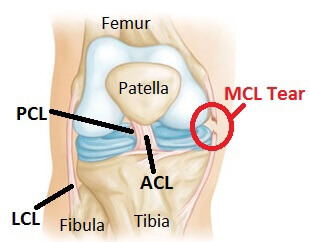|
BOOK NOW |
ASK ABOUT YOUR PAIN |
Home > Blog > Physiotherapy > Conditions We Treat > Knee Pain > Knee Medial Collateral Ligament (MCL) Sprain or Tear
Knee Medial Collateral Ligament (MCL) Sprain or Tear physiotherapy singapore

Our knee medial collateral ligament is a strong and flat connective tissue that's found on the inner side of our knee that connects our thigh bone (femur) to our shin bone (tibia) and prevents them from distancing / separating each other on the inner part of the knee.
It stabilizes the knee so that we can move about properly without pain or fear of knee buckling...but it can be damaged if it's overstretched due to accidents, trauma or forces that goes through the knee.
what's the Common Causes of knee MCL injuries and Tears?
Most of the time, a medial collateral ligament injury is caused by
- a strong force from the outer side of the knee, pushing into / through to the inner side of the knee, like a low kick from a kickboxer, or a side tackle or car accidents
- sudden twisting motion, like a pivot to change direction or awkward fall

HOW DOES IT FEEL?
When you experience an MCL injury, you may feel:
- Pain on the inner side of the knee
- Swelling and bruising at the inner side of the knee
- Swelling that spreads to the rest of the knee joint in 1 or 2 days following injury
- Stiffness in the knee
- Difficulty or pain when trying to bend or straighten the knee
- An unstable feeling, as though the knee may give out or buckle
- Pain or difficulty walking, sitting down, rising from a chair, or climbing stairs
knee mcl injury SIGNS AND SYMPTOMS
With an MCL injury, you may experience
- A "popping" sound as the injury occurs
- Pain and swelling in your knee
- Difficulty moving your knee
- Difficulty bearing weight on your leg for walking or getting up from a chair
knee medial collateral ligament injury grades
All ligamental injuries have 3 different grades of classification:
- Grade 1
- Grade 2
- Grade 3
Grade 1 is the mildest, with the least amount of ligamental fibers being damaged or torn. Usually presents with the least amount of pain or swelling, and most of the time, no knee instability and will heal up well naturally.
Grade 2 is moderate, with more pain and swelling, as well as potentially have some instability in the knee. The ligament is still intact together, though more fibers are torn. Patients here usually have more difficulties moving the injured knee or putting weight through it cos of the pain, and if the instability is prevalent, patient may need to do reconstructive knee surgery.
Grade 3 refers to a full rupture, separation of the ligament at the injury point. It typically presents with the most bruising, most knee pain, most knee stiffness and swelling. Lots of knee instability is expected, and there is very high chance that patient will need to do a surgical knee repair.
HOW IS IT DIAGNOSED?
If you see our senior physical therapist first, we will conduct a thorough evaluation that includes taking your health history. We will also ask you detailed questions about your injury, such as:
- Did you feel pain or hear a "pop" when you injured your leg?
- Did you turn your leg with your foot planted on the ground?
- Did you change direction quickly while running?
- Did you receive a direct hit to the leg while your foot was planted on the ground?
- Did you see swelling around the knee in the first 2 to 3 hours following the injury?
- Does your knee feel like buckling or giving way when you try to use it?
We also will perform special tests to help determine the likelihood that you have an MCL injury. We will gently press on the outside of your knee while it is slightly bent as well as when it is fully straight to test the strength of the ligament.
We will also check the inner side of your knee for tenderness and swelling and measure for swelling with a tape measure. The therapist may use additional tests to determine if other parts of your knee are injured, and will also observe how you are walking.
To provide a definitive diagnosis, we may collaborate with an orthopedic doctor or other health care provider. The orthopedic physician may order further tests, such as magnetic resonance imaging (MRI), to confirm the diagnosis and to rule out other damage to the knee.
The MRI scanning will also help to determine whether surgery is required.
MRI is not required in all cases but may be ordered to determine the severity of the medial collateral ligament injury or if there is any other secondary/additional structures that are damaged.
We or your doctor may recommend
- a knee brace
- a knee immobilizer or
- crutches
to reduce pain if the MCL injury is severe.
knee mcl injury physiotherapy singapore
The First 24-48 Hours
In the early / beginning stage of knee sprain, what our knee physios will focus on is to first quickly and rapidly work on
- reducing knee pain (pain relief)
- reducing swelling in the knee
By reducing pain, you can participate in more normal activities such as walking, going to work, self care etc, and reducing swelling will decrease knee joint stiffness too.
Our senior physiotherapists may advise you to:
- Rest the area by avoiding walking or any activity that causes pain. Crutches and a knee brace may be recommended to reduce further strain on the MCL when walking.
- Apply cold therapy to the area for 15-20 minutes every 2 hours.
- Compress the area with an elastic bandage wrap.
- Consult with a physician for further services such as medication or diagnostic tests.
After that, we'll need to start knee physiotherapy
Once the knee pain and swelling is being managed, and you can comfortably start moving your painful knee, next, we will start some knee exercises to regain knee movement / range of motion.
As you extend and bend your knee actively with knee exercises, it will also improve your knee strength and function too. These exercises are really, really important after a knee sprain injury to help your knee fully recover, so you must do them diligently okay.
At the later stage, we will work on
- knee strengthening with resistance
- balance training (lower and higher)
- activity and sports-specific knee training
so that you can get back to 100% knee function, power and stability.
We may use different types of treatments and technologies to control and reduce your pain, including
- cold therapy
- heat therapy
- ultrasound therapy
- radio-frequency Indiba physiotherapy
- manual therapy
- deep tissue release
- stretching exercises
- taping
- joint mobilization
Improve Motion
We will choose specific activities and treatments to help restore normal movement in the knee and leg. These might begin with passive motions that we will do for you to gently move your leg and knee joint, and progress to active exercises and stretches that you do yourself.
Improve Strength
Certain exercises will aid healing at each stage of recovery; your physical therapist will choose and teach you the correct exercises and equipment to steadily restore your strength and agility.
These may include using
- cuff weights
- stretchy bands
- weight-lifting equipment
- and cardio-exercise equipment such as treadmills or stationary bicycles
Regaining your sense of balance is important after an injury. We will teach you exercises to improve your balance skills.
Speed Recovery Time
Normal healing of time is a few weeks to a few months, depending on which tissues are injured and how severely they are injured. We're trained and experienced in choosing the right treatments and exercises to help you heal, return to your normal lifestyle, and reach your goals faster than you are likely to do on your own.
Return to Activities
We will discuss your goals with you and use them to set your work, sport, and homelife recovery goals. We will design your treatment program to help you reach those goals in the safest, fastest, and most effective way possible.
We will apply hands-on therapy, such as massage, and teach you exercises, work retraining activities, and sport-specific techniques and drills to help you achieve your goals
If You Need / Opt For Knee Surgery
Let me say this upfront - most of the time, most patients with knee sprains will likely not need invasive knee surgeries or ligament reconstruction surgeries (like I did) but if a knee surgery is needed, you will follow a recovery program over several weeks guided by our senior physical therapist, who will help you
Only a minority handful of knee sprains will benefit from a knee surgery, and the criteria are:
- PAIN: how frequent, persistent and intense is the knee pain
- INSTABILITY: is the knee buckling or unstable all the time, causing difficulty with walking? Plus each time the knee buckles, there is damage to the knee joint, meniscus and cartilage too
- GOAL: if patient was very active and wants to go back to high intensity sports, then it's high chances of needing a surgery
We will work with you to
- minimize pain
- regain 100% motion
- regain 100% strength and
- return to normal activities as quickly as possible after surgery